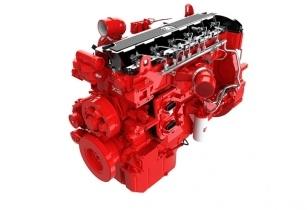Cummins has introduced the X12 engine with up to 360 kW output for powering full size touring and intercity coaches
Certified to the Phase-D stage of Euro VI regulations, the X12 incorporates a highly efficient in-cylinder combustion formula eliminating the need for exhaust gas recirculation (EGR).
Other advanced design features include techniques to minimise friction losses and a weight-saving sculptured engine block. The result is a fuel-saving 11.8-litre engine with a low weight under 920 kg, but with the heavy-duty strength and uncompromising on-road performance required for 12-to-15 metre high deck coaches.
The high flow air-handling system of the X12 gives a faster pedal response to enhance driveability at full vehicle loading, together with a rapid gradient climbing ability. A high peak torque of up to 2300 Nm is delivered across a wide engine speed range, so less shifting is needed, and less fuel is used. The engine braking delivers 275 kW at 2100 rpm.
The sculptured block design allows unnecessary mass to be removed but retains rigidity. Substantial weight savings are achieved by using high-strength composite materials for the oil pan and valve cover. A vital design approach with the X12 was to minimising friction losses throughout the engine, including the water pump, gear train, lube system and power cylinder.
The XPI fuel system on the X12 is derived from the more powerful X15 engine, with Cummins injection technology enabling smooth and rapid engine response to increasing vehicle demands, while minimising fuel consumption. XPI also contributes to reducing engine noise, vibration and harshness (NVH) to provide a more relaxed journey.
EGR-Free Combustion
The EGR-free X12 lowers heat rejection by around 40 per cent compared with that of similar engines using cooled EGR, allowing the full power potential of the X12 to be realised while meeting Euro VI Phase-D.
No EGR means a lower combustion temperature and less to cool, which helps to reduce the vehicle integration effort and cost. X12 architectural simplicity is further reflected in the use of a Cummins high-efficiency wastegate turbocharger, as the base engine already provides high power density without requiring a more complex turbocharging boost system.
The architecture of the X12 contributes to the goal of a global engine platform. While meeting Euro VI, the X12 and the X11 version are co-certified to meet NSVI in China and are ready to meet equivalent low emission standards as they are introduced in countries including Brasil, India, Australia and Mexico.
Nearer-To-Zero Phase-D
The low emissions credentials of the X12 are further enhanced by meeting the Phase-D requirement of Euro VI, representing a nearer-to-zero incremental step that will help coach fleets align with the introduced of Low Emission Zones being established in European cities.
The Phase-D regulations focus on tighter control limits for Nitrogen Oxides (NOx) emissions during lower speed operations, as well as under cold engine start conditions. In addition to emissions test cell verification, the Phase-D regulations required on-road testing to capture real-world measurement.
Duty cycle-based testing using high precision Portable Emissions Measurement systems (PEMs) installed on Cummins-powered vehicles has indicated a 25 per cent reduction in NOx emissions, compared to the Phase-A engines when Euro VI was introduced in 2015.
This Phase-D development work required a substantial investment by Cummins to meet the stringent requirements without the need to change engine hardware. The design focus stayed on the control logic and creating a new algorithm for the emissions management system, by refining and retesting the software over a two-year period.



